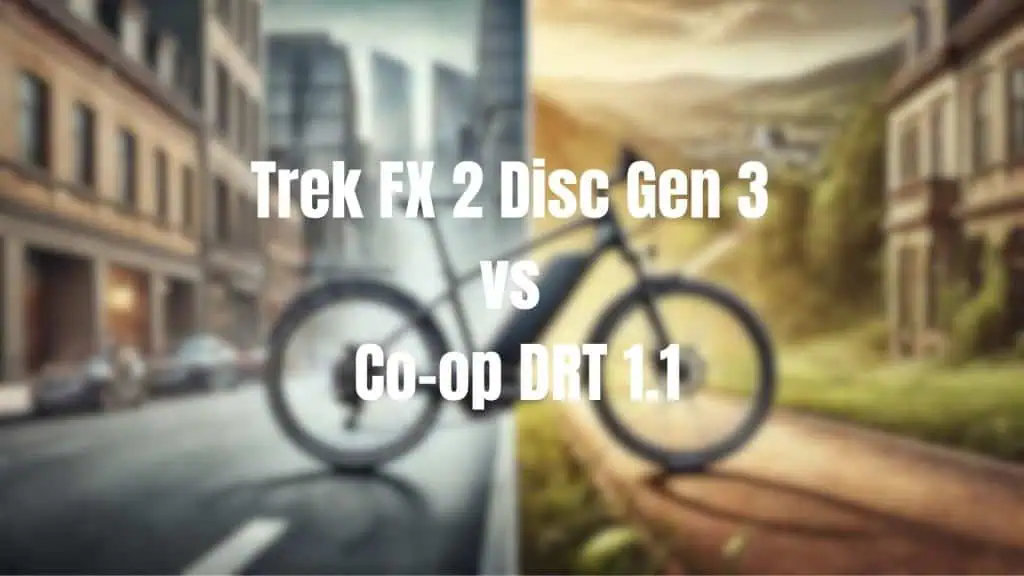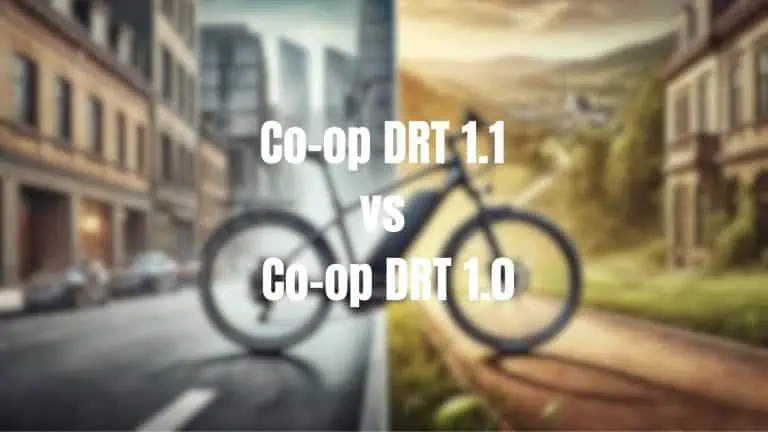Trek FX 2 Disc Gen 3 vs Co-op DRT 1.1: A Detailed Comparison

Trek FX 2 Disc Gen 3 and the Co-op DRT 1.1 represent two different approaches to cycling. While the FX 2 is a hybrid bike designed for efficient urban riding and light trails, the DRT 1.1 is an entry-level mountain bike built for more rugged off-road use. This detailed comparison will help you understand the unique characteristics of each model and determine which might better suit your cycling needs.
Comparison Table
| Feature | Trek FX 2 Disc Gen 3 | Co-op DRT 1.1 |
|---|---|---|
| Price | $799.00 | $599.00 |
| Bike Type | Hybrid Bike | Mountain Bike |
| Frame Material | Alpha Gold Aluminum | 6061 aluminum |
| Wheel Size | 700c | 27.5 inch |
| Suspension | No Suspension | Front Suspension |
| Drivetrain | Shimano | Shimano |
| Gearing | 18 gears | 21 gears |
| Brakes | Hydraulic Disc | Hydraulic Disc |
| Weight | 26 lbs | 31 lbs. |
Price and Value
- Trek FX 2 Disc Gen 3: $799.00
- Co-op DRT 1.1: $599.00
The Trek FX 2 Disc Gen 3 is $200 more expensive than the Co-op DRT 1.1. This price difference likely reflects the FX 2’s more urban-focused components and potentially higher-grade frame material, despite the DRT 1.1 having front suspension.
Bike Type and Frame Material
- Trek FX 2 Disc Gen 3: Hybrid Bike, Alpha Gold Aluminum
Trek’s Alpha Gold Aluminum is their higher-grade aluminum, known for its light weight and strength. The hybrid design blends elements of road and mountain bikes, making it versatile for various riding conditions, particularly in urban environments and on light trails. - Co-op DRT 1.1: Mountain Bike, 6061 aluminum
The DRT 1.1 uses 6061 aluminum, which is common for entry-level mountain bikes. It offers a good balance of strength, light weight, and affordability. As a mountain bike, it’s built to handle more rugged off-road terrain, with geometry and features optimized for trail riding.
The choice of frame material and bike type significantly impacts the ride quality and intended use of each bike. The FX 2 is designed for efficiency and versatility in mainly urban settings with some light trail capability, while the DRT 1.1 is built for stability and performance on more challenging off-road terrain.
Wheel Size
- Trek FX 2 Disc Gen 3: 700c
- Co-op DRT 1.1: 27.5 inch
This is a notable difference. The FX 2’s 700c wheels are standard for road and hybrid bikes, providing good rolling efficiency and speed on paved surfaces.
The DRT 1.1’s 27.5-inch wheels offer a good balance between the agility of smaller wheels and the roll-over ability of larger ones, making them popular for trail riding. They’re typically paired with wider, knobby tires for better traction on varied terrain.
Suspension
- Trek FX 2 Disc Gen 3: No Suspension
- Co-op DRT 1.1: Front Suspension
This is another key difference. The FX 2’s rigid fork keeps the bike lighter and more efficient on smooth surfaces. The lack of suspension also means fewer moving parts and less maintenance.
The DRT 1.1’s front suspension fork is designed to absorb impacts and vibrations from rough trails, providing more comfort and control in off-road conditions. However, this comes with a weight penalty and can reduce pedaling efficiency on smooth surfaces.
Drivetrain and Gearing
- Trek FX 2 Disc Gen 3: Shimano, 18 gears
- Co-op DRT 1.1: Shimano, 21 gears
Both bikes use Shimano components, which are known for their quality and reliability. The DRT 1.1 offers more gears (21 vs 18), potentially providing more options for tackling varied off-road terrain.
The FX 2’s 18-speed system likely offers a good range for urban riding and light trails, while keeping the system simpler.
Brakes
Both bikes feature hydraulic disc brakes, ensuring excellent stopping power and control in various conditions. This is a tie in terms of braking performance, with both bikes offering top-tier braking systems for safety and control in their respective environments.
Weight
- Trek FX 2 Disc Gen 3: 26 lbs
- Co-op DRT 1.1: 31 lbs.
The FX 2 is 5 pounds lighter than the DRT 1.1. This weight difference is noticeable and could impact the bikes’ handling and ease of transport. The FX 2’s lighter weight could make it more agile and easier to accelerate, while also being easier to carry up stairs or lift onto a bike rack.
The DRT 1.1’s additional weight is due to its front suspension fork and more robust construction for off-road use.
Riding Position and Comfort
The riding positions of these bikes are likely quite different:
- The FX 2 probably offers a more upright position compared to a road bike, but still relatively forward-leaning for efficient power transfer. This position balances comfort and performance for urban riding and light trails.
- The DRT 1.1 likely has a more upright riding position typical of mountain bikes. This position offers better control and visibility on trails, and can be more comfortable for some riders, especially on rougher terrain.
The DRT 1.1’s front suspension will provide more comfort on rough terrain, while the FX 2 is optimized for smooth urban surfaces and light trails.
Which is Better?
The choice between the Trek FX 2 Disc Gen 3 and the Co-op DRT 1.1 depends on your primary riding environment and personal preferences:
- Terrain: If you plan to ride primarily on paved roads and smooth urban paths with occasional light trails, the FX 2 is the better choice. If you want to explore more rugged off-road trails, the DRT 1.1 is the clear winner.
- Efficiency vs. Versatility: The FX 2 offers better efficiency on paved surfaces. The DRT 1.1 provides more versatility for varied terrain, including more serious off-road capability.
- Comfort: For urban riding and light trails, the FX 2’s more efficient design may be more comfortable. For rough terrain, the DRT 1.1’s suspension will provide better comfort.
- Weight: If you need to carry your bike frequently or prefer a more nimble ride on pavement, the FX 2’s significantly lower weight is a big advantage.
- Price: The DRT 1.1 is less expensive, offering good value for an entry-level mountain bike.
In conclusion, the Trek FX 2 Disc Gen 3 is the better choice for riders who primarily cycle in urban environments or on paved surfaces, with occasional forays onto light trails. It’s ideal for commuters, fitness enthusiasts, and those looking for a versatile bike that excels on pavement but can handle some light off-road use.
The Co-op DRT 1.1 is better suited for riders who want to explore more serious off-road trails or need a bike capable of handling both paved and unpaved surfaces. It’s a great entry-level mountain bike that can also serve as a rugged commuter for those dealing with rough roads or mixed terrain.
Consider your primary riding environment, the type of terrain you’ll most often encounter, and your cycling goals when making your decision. If you’re primarily a city rider with some light trail use, go for the FX 2. If you have a strong interest in off-road riding or need to deal with rougher terrain regularly, the DRT 1.1 would be the better option.






